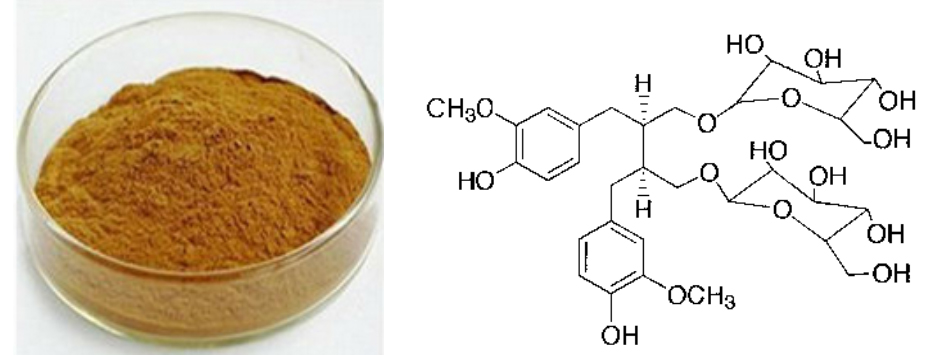Personlized Products Flaxseed Extract in Korea
Personlized Products Flaxseed Extract in Korea Detail:
[Latin Name] Linum Usitatissimum L.
[Plant Source] from China
[Specifications]SDG20% 40% 60%
[Appearance] yellow brown powder
Plant Part Used:Seed
[Particle size] 80 Mesh
[Loss on drying] ≤5.0%
[Heavy Metal] ≤10PPM
[Storage] Store in cool & dry area, keep away from the direct light and heat.
[Shelf life] 24 Months
[Package] Packed in paper-drums and two plastic-bags inside.
[Net weight] 25kgs/drum
Product description:
Flaxseed extract is a kind of plant ligan most notably found in flaxseed. Secoisolariciresinol diglycoside, or SDG is existed as its main bioactive components. SDG is classified as a phytoestrogen since it is a plant-derived, nonsteroid compound that possesses estrogen-like activity. Flaxseed extract SDG has weak estrogenic activity, when intake as food it will be trasfer to flax ligan which have same structure with estrogens.The level of SDG in flaxseed typically varies between 0.6% and 1.8%. Flaxseed extract powder SDG can reduce the blood lipid, cholesterin and triglyceride, it can also prevent for apoplexy, hyperension, blood clots, arteriosclerosis and arrhythmia. In addition, flax seed extract powder SDG is benificial for diabetes and CHD.
Main Function:
1.Flaxseed extract used to lose weight. Can burn surplus fat of Body;
2.Flaxseed extract will reduce allergic reaction, reduce asthma, improve arthritis;
3.Flaxseed extract with the function of improving female menstrual period syndrome;
4.Flaxseed extract can reduce the bad influence of hazardous chemicals produced when under pressure, control Stress, reduce depression and insomnia;
5.Flaxseed extract will improve skin fat content, moisten the skin smooth, soft and flexible, make the skin breath and sweat to normal, to mitigate various skin problems.
Product detail pictures:

Related Product Guide:
Our company insists all along the quality policy of "product quality is base of enterprise survival; customer satisfaction is the staring point and ending of an enterprise; persistent improvement is eternal pursuit of staff" and the consistent purpose of "reputation first, customer first" for Personlized Products Flaxseed Extract in Korea , The product will supply to all over the world, such as: Jamaica, Spain, El Salvador, To let customers be more confident in us and get the most comfortable service, we run our company with honesty, sincerity and best quality . We firmly believe that it is our pleasure to help customers to run their business more successfully, and that our experienced advice and service can lead to more suitable choice for the customers.
You can find more how to increase libido after childbirth at
https://www.naturalwomenhealth.com/natural-female-sex-drive-enhancer-pills.htm
Dear friend, in this video we are going to discuss about the how to increase libido after childbirth. Fantasy capsules are the best natural sexual enhancement pills to increase libido after childbirth and improve overall stamina.
If you liked this video, then please subscribe to our YouTube Channel to get updates of other useful health video tutorials.
How To Increase Libido After Childbirth
We are committed to bringing benefits to our clients, the Stevia industry and more people by providing healthy and valuable Stevia products in a sustainable way.
GreenHerb involves the whole supplying chain,
started from land and herb, including cultivation, farming,
processing, products and solutions.
Tel : +86 29 8621 2902
Fax: +86 29 8621 2903
Email: info@greenherb.cn
https://www.greenherb.cn/
We have been appreciated the Chinese manufacturing, this time also did not let us disappoint,good job!







